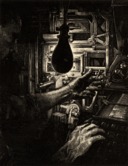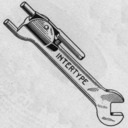[This site is in the process of a rather massive reorganization and rewrite. The organization of this present page reflect this (scrambled) and most of the links won't work right now. It'll get better - really. ]
The Notebooks here are high-level "semi-technical" historical surveys of the equipment. For detailed technical information, see the ../ Mechanics: Type Machinery In Detail set of Notebooks.

Composing Linecasters
Linotype Principles Linotype and Linotype-Compatible Manufacturers and Models. Major Accesories, Features, and Third-Party Devices for Linotypes and Intertypes. Other Commercially Successful Composing Linecasters (the Linograph and the Rogers Typograph).

Noncomposing Linecasters
[NOT DONE] [Ludlow.] [All-Purpose Linotype ("A-P-L")] [Nebitype.]
[Note that while the Ludlow may be thought of as a display type (line)caster complementary to a composing linecaster, the equivalent Monotype display type caster becomes a "noncomposing typecaster" and thus merges into the "Sorts Caster" category; see below.] [A-P-L illus. in Karch. Printing and the Allied Trades 2ed. p. 107] [A-P-L book from Merg.]
It was also possible to treat an Intertype as a noncomposing linecaster with its "Stick Attachment." I'll cover this (if I get to it; I don't have a Stick Attachment) with Intertypes, though.

Stripcasters / Material Makers
[NOT DONE] [Elrod.] [Monotype Type and Rule Maker.] [Monotype Material Maker.]

Common Casting Equipment
("Common" in the sense of "used with multiple kinds of casting machines.")

Hot Metal Paraphernalia
[THIS REFLECTS AN OLDER ORGANIZATION; move most of this down into the "composing linecaster" section, and the rest of it into "common casting equipment"] It isn't enough simply to have a caster. They require quite a few supplemental tools, consumable supplies, and accessories, including:
[MOST SUBTOPICS LISTED, but not yet illustrated] [Basic Attire (e.g. leather shoes, safety glasses).] [Basic Hand Tools for Everyday Use (e.g., pot skimmers.)] [Consumables (e.g., oils and graphite.)] [Frequently Needed Parts/Accessories (e.g., molds and mold liners.)] [Fancier Tools and Auxiliary Machines (excluding matrix tools.)] [Matrix Tools.] [Crucible (Pot) Accessories.] [Ingot Casting Tools and Supplies.] [Matrices.] [Even Fancier Tools] [Cabinetry and Furniture.]

Services for Hot Metal Machines
[THIS REFLECTS AN OLDER ORGANIZATION; move most of this down into the "composing linecaster" section.] [INCOMPLETE] Services currently available. [NOT DONE] [Services formerly available.]

Noncasting Type Composing Machinery
E.g., the Paige or the Thorne/Simplex/Unitype.
This set of Notebooks has been moved to ../ Noncasting Type Composing Machinery

Other Equipment
[THIS REPRESENTS AN OLDER ORGANIZATION; merge the topics here into "Composing Room Equipment," etc.] Type. Composing Room Machinery (Saws, Routers, etc.) Rule and Rule Work. Paper. Presses. Binding to some limited extent.

Bindery
Paper handling (cutting, folding) and bookbinding equipment normally found in an older printing establishment. (For similar equipment intended for an office environment, see An Office Miscellany up and over in the Typefounding, Lettering, & Printing set of Notebooks.)
[Note: These Notebooks show all sorts of fun equipment. You don't need it all to do printing! For a simple start with as little as possible, see the Notebook on How to Print with Very Little Equipment . You don't even need a printing press.]
This is just a brief illustrated overview of many (though by no means all) of the various machines, tools, and other components of letterpress printing for both hand set type and "hot metal" type. It simply illustrates the equipment. Other Notebooks cover my experiences with the technical details of the construction, maintenance, and restoration of some of this equipment in greater detail. Still other Notebooks discuss my use of some of this equipment (I don't have all of it, alas). For these, go up a level to the CircuitousRoot Press.
As I began learning about this field, I kept discovering more and more kinds of machines, and indeed kinds of processes. It can be a bit overwheling at first. Don't think of it as confusing, though - think of it as a celebration of human ingenuity.
The discussion here covers much more equipment than any one shop would have ever had. (It would have been unusual to find a Linotype shop running Monotype as well, I would suppose, and a pure hand composition does not require any of the "hot metal" equipment.) A printing traditionalist would cover these in a different order, but I'm a Linotype nut, so those go first here.
All portions of this document not noted otherwise are Copyright © 2008-2011 by David M. MacMillan and Rollande Krandall.
Circuitous Root is a Registered Trademark of David M. MacMillan and Rollande Krandall.
This work is licensed under the Creative Commons "Attribution - ShareAlike" license. See http://creativecommons.org/licenses/by-sa/3.0/ for its terms.
Presented originally by Circuitous Root®
Select Resolution: 0 [other resolutions temporarily disabled due to lack of disk space]